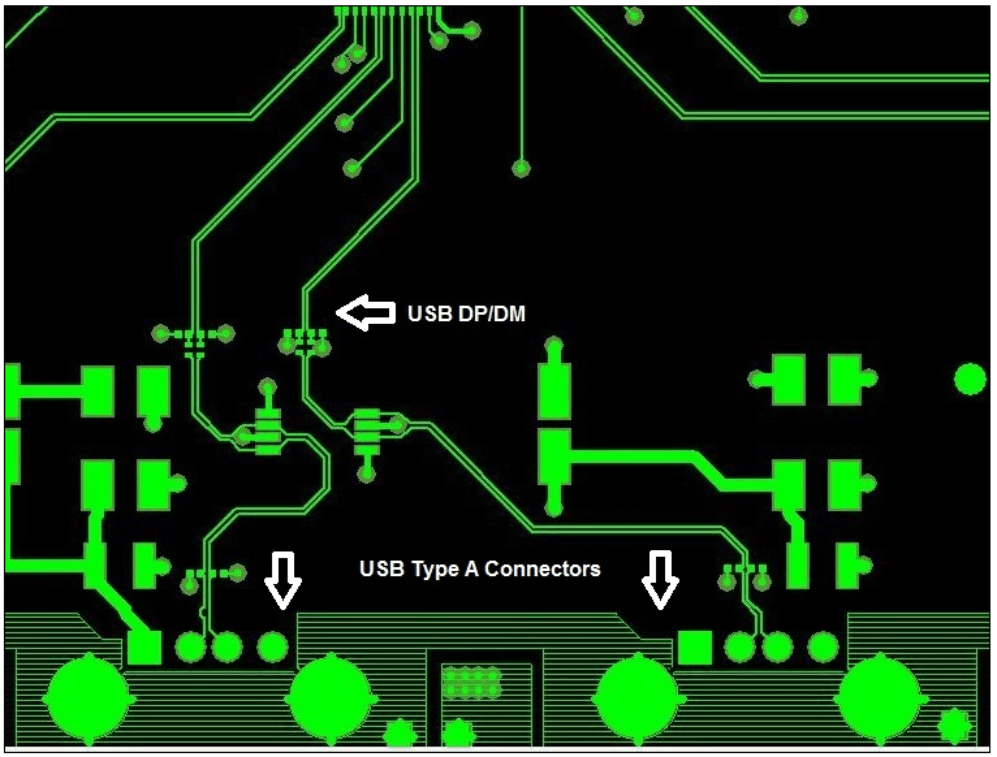SLLS414F March 2000 – August 2015 TUSB2077A
PRODUCTION DATA.
- 1 Features
- 2 Applications
- 3 Description
- 4 Revision History
- 5 Description (Continued)
- 6 Pin Configuration and Functions
- 7 Specifications
- 8 Detailed Description
- 9 Application and Implementation
- 10Power Supply Recommendations
- 11Layout
- 12Device and Documentation Support
- 13Mechanical, Packaging, and Orderable Information
パッケージ・オプション
デバイスごとのパッケージ図は、PDF版データシートをご参照ください。
メカニカル・データ(パッケージ|ピン)
- PT|48
サーマルパッド・メカニカル・データ
発注情報
11 Layout
11.1 Layout Guidelines
11.1.1 Placement
- A 0.1-μF should be placed as close as possible on VCC power pin.
- The ESD and EMI protection devices (if used) should also be placed as possible to the USB connector.
- If a crystal is used, it must be placed as close as possible to the XTAL1 and XTAL2 pins of the TUSB2077A.
- Place voltage regulators as far away as possible from the TUSB2077A, the crystal, and the differential pairs.
- In general, the large bulk capacitors associated with the power rail should be placed as close as possible to the voltage regulators.
11.1.2 Differential Pairs
- Must be designed with a differential impedance of 90 Ω ±10%.
- Route all differential pairs on the same layer adjacent to a solid ground plane.
- Do not route differential pairs over any plane split.
- Adding test points will cause impedance discontinuity and will therefore negative impact signal performance. If test points are used, they should be placed in series and symmetrically. They must not be placed in a manner that causes stub on the differential pair.
- Avoid 90-degree turns in trace. The use of bends in differential traces should be kept to a minimum. When bends are used, the number of left and right bends should be as equal as possible and the angle of the bend should be ≥ 135 degrees. This will minimize any length mismatch causes by the bends and therefore minimize the impact bends have on EMI.
- Minimize the trace lengths of the differential pair traces. The maximum recommended trace length for USB 2.0 differential pair signals is 8 inches. Longer trace lengths require very careful routing to assure proper signal integrity.
- Match the etch lengths of the differential pair traces. The USB 2.0 differential pairs should not exceed 50 mils relative trace length difference.
- Minimize the use of vias in the differential pair paths as much as possible. If this is not practical, make sure that the same via type and placement are used for both signals in a pair. Any vias used should be placed as close as possible to the TUSB2077A device.
- Do not place power fuses across the differential pair traces.
11.1.3 Ground
TI recommends using only one board ground plane in the design. This provides the best image plane for signal traces running above the plane. The thermal pad of the TUSB2077A and any of the voltage regulators should be connected to this plane with vias. An earth or chassis ground is implemented only near the USB port connectors on a different plane for EMI and ESD purposes.
11.2 Layout Example
 Figure 11. TUSB2077 Layout Example
Figure 11. TUSB2077 Layout Example